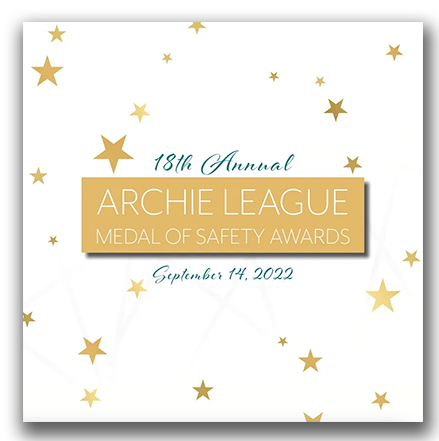
2022 Winners of the 18th Annual Archie League Medal of Safety Awards
Alaska Region: Brent Eber, Nathan Midthun, Merrill Field ATCT (MRI)
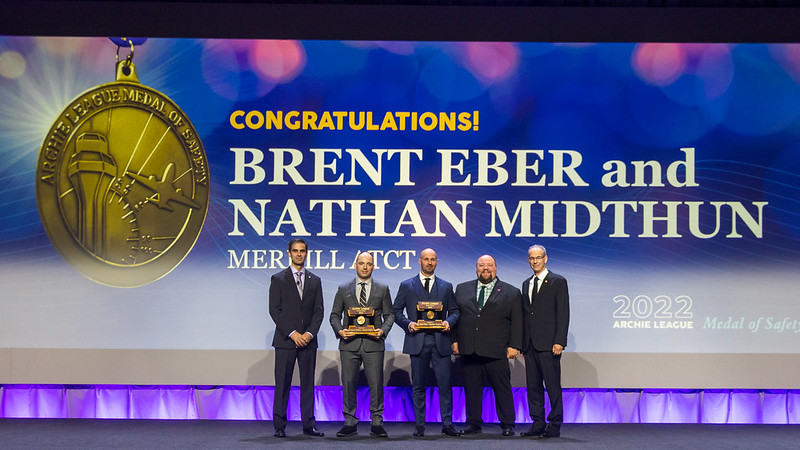
Article by Eric Mauro (Merrill Field ATCT, MRI)
The airspace around the Anchorage bowl is a complex mix of General Aviation, Commercial Air Carrier, Air Taxi and Military operations. Complicated airspace restrictions and proximity to airports create a very dynamic and often challenging array of air traffic scenarios.
Merrill Field (MRI) was established in 1930 and is situated in the heart of downtown Anchorage, Alaska. With proximity to Anchorage International Airport (ANC) and shared airspace boundaries with both Lake Hood (LHD) and Elmendorf Air Force Base (EDF), MRI can often be described as “fun chaos that happens every day” says MRI member Nathan Midthun.
On the morning of Dec. 8, 2021, MRI was finishing up snow removal operations from a winter storm the day before. Airport operations were actively clearing snow on the arrival end of Runway 07, while aircraft operations were being reduced to the smaller crosswind Runway 34.
Meanwhile at Anchorage International, TransNorthern 123 (a Douglas DC3 manufactured in 1952) was departing Runway 07L en route to Kodiak, Alaska with a load of cargo. Shortly after takeoff, TransNorthern 123 experienced a loss of engine power and requested to return for landing. Anchorage controllers quickly coordinated with MRI and informed them of the situation. TransNorthern 123 advised that that they would be continuing north bound into MRI’s airspace due to a reduced climb rate.
MRI member Brent Eber was working the Local Control position when he noticed TransNorthern very low over the city. Eber worked all over the world as an air traffic controller with the United States Air Force before beginning his career with the FAA in 2008. As a veteran controller, Eber knew something wasn’t right. As he looked out at the DC3 through binoculars, “it just didn’t seem like he was climbing, and that MRI was a viable option for landing” says Eber. Eber also recognized the pilot was a regular at MRI and had considerable experience flying in and out. Eber sprang into action and immediately instructed the snow removal vehicles to exit the runway where they were working.
Meanwhile, Midthun was working as Controller in Charge. Midthun is a lifelong Alaskan who studied as a commercial aviation student before moving into air traffic control at the University of North Dakota. Midthun took the initial call from Anchorage Tower that TransNorthern 123 was having difficulties and offered Merrill’s runways if needed. “Because we are in such close proximity to other airports, we are used to relaying information quickly,” said Midthun. He worked to get the information to the Anchorage Fire Department as Merrill Field has no crash, fire, or rescue. “A DC3 landing at Merrill with no gear down, that’s pretty unusual,” said Midthun
A moment later, TransNorthern 123 made the transmission “Mayday, we are putting it down at Merrill! Runway 7 at Merrill, Runway 7 at Merrill!” As TransNorthern 123 made the turn for MRI, Eber could make out they would be in very close proximity to the snow removal vehicle working on the taxiway. “Airport 4, Move! Move! Move!” Eber said with urgency. Shortly after, TransNorthern 123 made a gear up emergency landing on runway 7 narrowly missing the airport vehicle. They all walked away with no injuries. Airport personnel Steve Pedersen who was working snow removal that day later credited Eber with saving his life.
Heroic flying from the two TransNorthern 123 pilots and a solid tower team concept from both Midthun and Eber paved the way for a positive outcome that cold December morning. “For the tower team to get everything organized and together within that short period of time was amazing to see,” said Eber.
“Merrill Field sees aircraft emergencies often but not typically to this extent,” said Eber. This Archie award will be Merrill Field’s first. “This award means everything. My career goal has been to produce a very safe environment for pilots to operate in,” said Midthun.
“This is where your training comes in. When you’re in the heat of the moment you don’t have time to think about what you should be doing next. You were trained in a very specific way in how to handle these events. You can snap back to that basic training, do what you need to do, and work past the extra stress,” said Midthun.
“Brent and Nathan displayed an outstanding amount of situational awareness that day. They not only worked their own complex operation that day, but they also maintained great awareness of what was happening outside of their airspace. Brent and Nathan were able to take a difficult and quickly evolving situation and turn it into the best possible outcome for both the pilots of TransNorthern 123 and the ground ops crew at MRI.”
– Alaskan Regional Vice President Clint Lancaster
Watch the award presentation:
Highlights from this save:
Podcast below: Hear Owens, Rolofson, and Rosenbaum tell their story, in this episode of the NATCA Podcast.
Central Region: Brian Magnuson, Kansas City Center (ZKC)
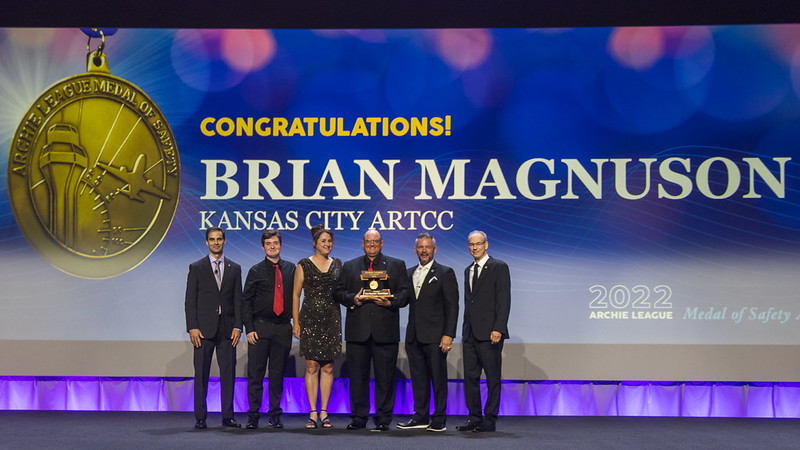
Article by Bryan Martini (Sioux Gateway ATCT, SUX)
On the afternoon of November 17, 2021, Kansas City Center (ZKC) member Brian Magnuson was working Sector 06 of ZKC’s Prairie Area as he has countless times before. This session, however, would be different than most other sessions working Sector 06.
N2RA, a Mitsubishi MU-2 enroute to Pueblo, Colorado at Flight Level 240 requested a lower altitude due to a pressurization problem. Immediately identifying the seriousness of the situation, Magnuson declared an emergency for the aircraft and descended N2RA to Flight Level 180. After coordinating with Vance AFB, N2RA was issued a further descent to 10,000 feet. As Magnuson points out, “Lack of oxygen is a very time sensitive issue, so we had to get him going.”
N2RA leveled at Flight Level 180 and Magnuson knew that the symptoms of hypoxia were taking effect as, “something wasn’t clicking with the pilot.” Listening to the recommendations of the area controllers who rallied behind him, Magnuson repeatedly transmitted “oxygen.” Another controller immediately began working to assist, taking care of coordination, while the controller working an adjoining sector helped separate traffic on the north half of Magnuson’s sector. A controller with pilot experience also came to back up Magnuson.
“The pilot reported that he was at Flight Level 180, and he did not sound good,” recounts Magnuson. He reissued the instruction to descend and continued to transmit “oxygen, oxygen, oxygen.” After descending approximately 2,000 feet, N2RA began making a steep left turn and looked to be in a possible spiral. Magnuson issued a 270 heading to stabilize the aircraft’s descent. The pilot began to regain control and corrected his heading. Magnuson continued to calmly instruct the pilot to descend and use oxygen, while another pilot on frequency broadcasted “Descend man, descend.” N2RA started to descend and as it passed 16,000 feet, “He started sounding better. He keyed up and it was the first time it sounded like I was talking to a pilot who was coherent.” When queried, the pilot stated he intended to continue to Pueblo, where he landed safely.
After N2RA’s safe arrival in Pueblo, the pilot called ZKC and expressed his gratitude by saying, “The controller that continued to talk to me in a calm, professional manner and kept telling me to descend over and over helped prevent me from passing out, and likely a different outcome.”
“Brian and the team from the Prairie area exemplify the professionalism, teamwork, and safety culture of ZKC. Because those traits are instilled in each team member, they’re ready for any unusual or unexpected situations and produce the best possible outcomes. These events that occurred on November 17, 2021, were no exception.”
– Central Regional Vice President Aaron Merrick
Watch the award presentation:
Highlights from this save:
Podcast below: Hear tell their story, in this episode of the NATCA Podcast.
Eastern Region: David Lomascolo, Eric Lomascolo – Potomac TRACON (PCT)
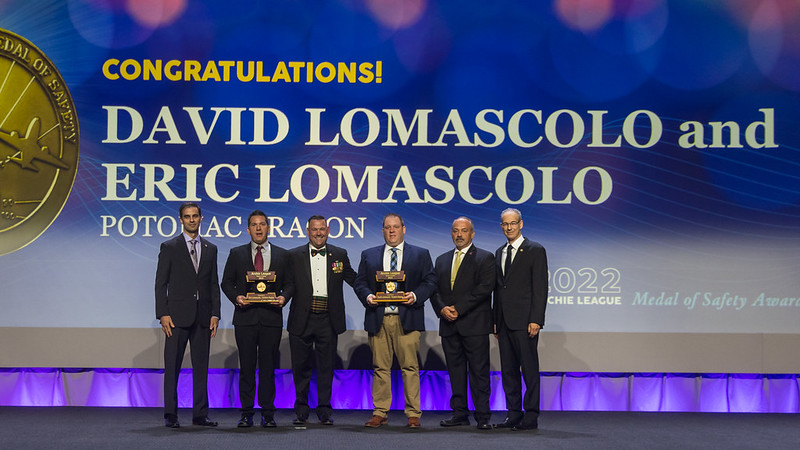
Article by Jaymi Steinberg (Washington Center, ZDC)
On a blustery winter day in January 2022, N3039L, a Socata Tobago, was inbound for Manassas Airport (HEF). Notably on this day, there was snow actively falling and the winds were roaring, causing a complex scenario for any pilot to contend with. As the pilot reached about 10 miles north of Frederick Airport (FDK) the pilot reported being shaken around and dealing with ingestion of ice into the engine. This led to additional issues, including problems with the vacuum. The aircraft then began to lose altitude. NATCA member Eric Lomascolo was working radar at Potomac Consolidated TRACON (PCT). He attempted to set the pilot up for a straight in ILS approach to Runway 23 to get the pilot on the ground as soon as possible.
Due to the short setup time and heavy gusts, the aircraft overshot the localizer. Everything happened quickly. This made Eric and his brother David, who also is a PCT member, aware that the pilot needed assistance. An emergency was declared on the pilot’s behalf. While this was going on, David, who was working Flight Data, was reaching out and attempting to assess the airport conditions at Frederick, including weather, braking action, and any possible pre-treatment. Frederick reported that the airfield had not been cleared, and in fact no aircraft had landed recently, so conditions were unknown. David attempted to get any assessment of the field, like the amount of snow covering the runway. The pilot was set up for a second approach to Frederick. The strong crosswinds and other complications led this second approach to not be viable.
The brothers utilized their weather awareness to set the pilot up for a third approach with a longer inbound course to allow the pilot to set up with less wind impact. Also, at this time the pilot reports, “I’m getting bounced all over the place sir, very violently.” The pilot also began experiencing autopilot challenges. David continued coordinating with FDK to procure emergency equipment—an additional challenge since there was no dedicated airport firefighter brigade. Frederick-area fire departments had to be called in. As the aircraft neared FDK, the pilot started to dip below altitude minima. The pilot advised ATC that he thought he lost his engine. Eric then cleared the pilot for ILS approach. Eric asked if the aircraft had any power; the pilot advised it was just sputtering.
Eric reached out via his frequency and Guard frequency to alert the aircraft. FDK turned their lights up to their maximum to try to help illuminate the way for N3039L. There was great relief when the FDK controller reported seeing the landing lights—the aircraft had a chance to make it to the field. Finally, N3039L successfully landed at FDK. Once the pilot was safely on the ground, he reached out to the facility to thank Eric and said, “I just wanted to personally thank you… That motor was sputtering, my gyro was freezing up… you were unflappable. That last correction hit me right on the ILS and made all the difference.”
Together, Eric and David were able to provide excellent teamwork which helped the pilot have the best chance for a successful landing.
About the event, the pilot recalled, “[even as] a retired Marine aviator, that was probably the most harrowing thing I have had happen in my entire aviation career. And Eric – his voice, his work… was unbelievable. His phenomenal calm under pressure. I cannot thank him enough.”
“The Eastern Region is proud to honor David and Eric Lomascolo for the calm, systematic approach they applied when faced with a challenging situation. Their awareness of weather, ability to adapt, and teamwork helped to secure a successful outcome for the aircraft in distress.”
– Eastern Regional Vice President Brian Shallenberger
Watch the award presentation:
Highlights from this save:
PODCAST: Hear discuss this event.
Great Lakes Region: Darren Groce – Indianapolis ATCT (IND) – retired
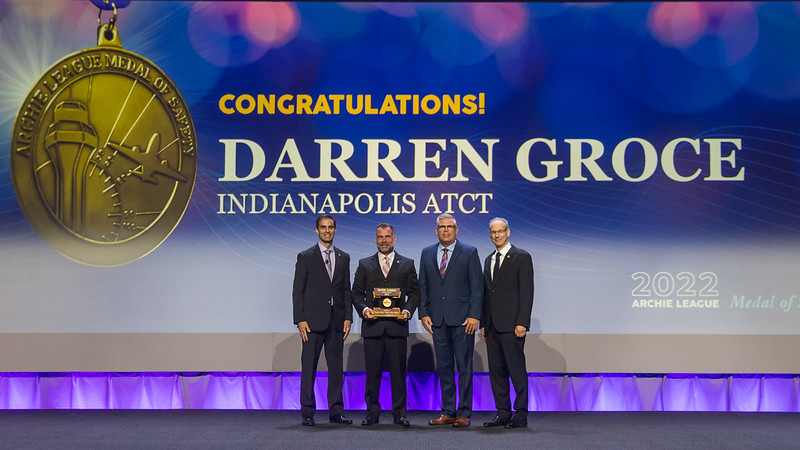
Article by Jennifer Malloy (Cleveland Center, ZOB)
On Sept. 21, 2021, one of Lift Academy’s aircraft (LTA47) departed from Runway 23L at Indianapolis Airport. Darren Groce was working the Departure East at Indianapolis Approach Control (IND), when he heard the pilot of LTA47 check on — “Approach, good morning.” After some frequency overlap, he heard the rest. “I have an ECU failure and lost my engine,” the pilot said.
Groce identified the position of LTA47 and responded with instructions to get the plane back to the airport. Groce quickly realized that circling back to land on the closest runway to them was not an option. They had just overflown Runway 23R, which was parallel to the runway they had just departed from but was closed for construction. A left turn back to land on Runway 5R also wasn’t an option because LTA47 would have conflicted with another aircraft that had just departed behind them. Groce determined that landing on RWY14 was the closest and most feasible for them.
Groce asked the pilot if they could make a right turn and go back in to Runway 14. The pilot read back, “Right turn, one four,” paused for a split second and said, “Uh, yeah. I think I can.” Groce could tell he understood, and that they were on the same page as he immediately started a right turn and headed toward the final for Runway 14. Groce observed that the aircraft had already lost approximately 500 feet of altitude from their initial check in, so he knew that time was critical in getting them back on the ground.
Groce coordinated with the tower as LTA47 dropped below radar coverage. The local controller yelled over to ground to hold everyone short since the engine of LTA47 was completely stopped and the aircraft was just rolling down the runway. Because of Groce’s clear communication, airport crash, fire, and rescue personnel were there to assist upon landing.
“I later learned from Lift Academy that the fuel pump gears on that aircraft had completely disintegrated, and there was no fuel going to the engine,” said Groce. “The pilot had no chance of getting the engine restarted.”
Groce’s quick action ensured that the pilot was able to land safely.
“Darren Groce’s quick thinking on September 7, 2021, was the determining factor that tipped the scales from disaster to miracle, as the pilot of LTA47 who had a complete engine failure upon takeoff was saved. We couldn’t be more proud of Darren who displayed the highest skills as he responded to this crisis. He was calm, composed, and absolute in his decision making. We are extremely proud to have Darren as the recipient of the 2022 Archie Medal of Safety Award for the Great Lakes Region.”
– Great Lakes Regional Vice President Drew MacQueen
Watch the award presentation:
Highlights from this save:
Listen below as Allan recounts the full story on an episode of The NATCA Podcast.
New England Region: Patrick Sullivan – Boston ATCT (BOS)
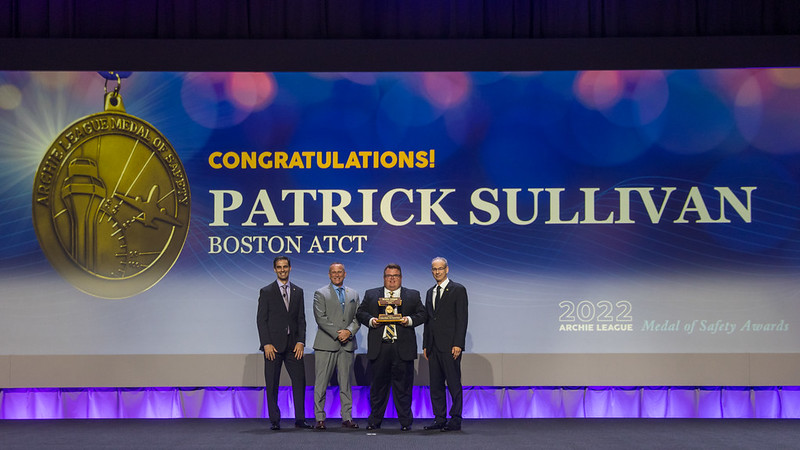
Article by Shannon Lyman (Boston Center, ZBW)
It was a typical Tuesday evening around 11:30 p.m. when Boston Tower (BOS) controller Patrick Sullivan was contacted by the pilot of N477GJ, a BE40, requesting to taxi to Runway 9. Patrick issued taxi instructions of Bravo, Charlie, and Mike with clearance to cross Runway 4L. The pilot read his clearance back incorrectly, which lead Sullivan to reissue the taxi clearance, which the pilot again read back incorrectly.
“In the back of your head, you are kind of like, I want to pay attention a little bit more to this particular pilot than normal,” Sullivan said, recalling the exchange.
As N477GJ started his taxi, he had the wrong code entered into his transponder, which Sullivan noticed as well. The pilot turned off his transponder to reset the code.
“I may have even given him the taxi instructions again, just to make sure,” Sullivan noted.
The airfield at Boston Logan International Airport (BOS) is complex. All the taxiways intersect runways, and it can be confusing for any pilot, particularly corporate pilots who are not routinely going in and out of BOS.
To get to Runway 9, you must cross Runway 4L and then make a 90 degree turn on Taxiway Mike, which brings you right to Runway 9. But this pilot did not do that. This pilot did not make the turn onto Taxiway Mike and was heading right for Runway 4R, which had an aircraft on short final.
“I jumped up and said, ‘STOP!’ and he stopped and said, ‘Thank you’ and asked if he was in trouble,” Sullivan recalled. “I said, ‘No, you didn’t cross the runway, you didn’t get onto the runway. Just stay right there.’”
Patrick decided the best course of action was to have the pilot hold position and eventually turn around on Runway 4R and taxi him to Runway 9, as initially assigned.
“Weren’t going to assign a new runway,” Sullivan said. “Make sure there’s no planes in the area, he can enter the runway he’s about to get on, turn around, and taxi to 9.”
Once N447GJ was turned around and taxied to Runway 9, he took off without incident.
“The controller who I was working with, Rob Lawn, who I work a lot with on overnights, he and I just looked at each other, and just took a deep breath and moved on,” Sullivan said.
This was a great save by Sullivan, but he made sure to note, “Many people I have worked next to over the years have done the same exact thing. It is just something you see, you do, you take a deep breath, and you move onto the next function.”
When asked what lessons he has learned over his 23-year career that led him to this level of awareness and safety, he credited the older controllers he has worked with in the past. Sullivan said they pushed him to make sure he was paying attention, that he was not turned around to the back of the tower cab having conversations. They engrained in him: “You can always be doing something. You are always going to catch something. Stuff is always happening.”
Sullivan recommends to the younger generation of air traffic controllers work to eliminate the distractions.
“I know it can be boring at times when you’re not busy,” Sullivan said. “But those are the times you really need to catch the mistakes.”
Congratulations to the NATCA Archie League Medal of Safety recipient for the New England Region, Patrick Sullivan of Boston Tower!
“The modern-day impediment to aviation safety is distractions. Patrick’s commitment to his craft and the safety of the National Airspace System were evident that night. His focus on every detail of his role as an air traffic controller during a midnight shift saved the aircraft involved from an impending life-threatening event. Congratulations Patrick and thank you for your dedication to safety!”
– New England Regional Vice President Mick Devine
Watch the award presentation:
Highlights from this save:
Listen below as Allan recounts the full story on an episode of The NATCA Podcast.
Northwest Mountain Region: Morgan Farmer, Jake Zakrzewski – Denver Center (ZDV)
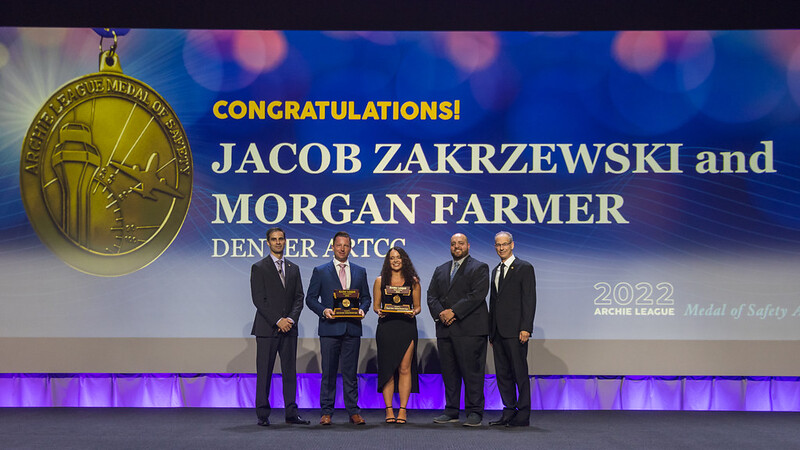
Article by Lydia Baune (Spokane ATCT, GEG)
Anytime controllers face an emergency, it can be challenging. In this case, an added challenge was that training was in progress. Jake Zakrzewski has been a controller at Denver Center (ZDV) in Area 1 for 10 years and is the primary on-the-job training (OJT) instructor for Morgan Farmer. Farmer has been in the Agency for nearly four years and had been training on R side for the sector for only one month when she and Zakrzewski helped N340JS, a twin engine Cessna 340, work through an emergency.
“Expect the unexpected. This should be the motto for Area 1 at Denver Center,” said ZDV FacRep Megan Nowak. “Area 1 has some very unique and challenging layers that add to its complexity. Mountainous terrain, unfavorable winter weather conducive to severe icing, severe turbulence, and IMC, on top of the traffic volume all play into the complexity of this low altitude sector at ZDV.”
On December 23, 2021, when Zakrzewski and Farmer plugged in to train on their first session of the day they were greeted with reports of severe icing and severe turbulence. Shortly after plugging in, N340J checked on. Zakrzewski and Farmer immediately noticed that he was having trouble maintaining altitude. They later determined that N340JS encountered severe icing, was unable to maintain altitude and descended below the Minimum IFR Altitude (MIA). Though the pilot never declared an emergency, the training team treated the situation as such.
“For me, as you gain more experience, especially working in a low altitude sector, you sort of have those alarm bells that are going off in the back of your head,” Zakrzewski said. “I knew there was lower terrain to the north, so we started vectoring him that way as he was descending.”
Meanwhile, the training team solicited a base report from a United aircraft they were working into MTJ and knew if N340 got down to about 11,000 feet, they should get into Visual Meteorological Conditions (VMC).
Eventually, N340J broke out of the clouds and reached VMC conditions, however they were not able to see the airport immediately due to a layer of ice covering their windshield. The ice gradually broke free from the windshield and other parts of the aircraft allowing the aircraft to regain positive control, get the airport in sight for a visual approach, and land safely.
“I am extremely grateful that this event had a positive outcome,” Zakrzewski said. “Bad things do happen. Pilots may know what to do, but they might not. If we are confident and calm, that might be all that the pilots need to help move them from one task to the next.”
When asked what the award means to them, Zakrzewski and Morgan were both full of gratitude for the people on their team.
“We have a lot of excellent controllers here at Denver Center. As far as NATCA, I’m extremely proud to be just a small part of this,” Farmer said. “We are in this together and I am thankful that NATCA is there to be that for all of us.”
“Thanks to the quick actions of Morgan Farmer and Jake Zakrzewski, the pilot of N340JS/C340 that was losing altitude due to severe icing was saved that day. We couldn’t be more proud of these two members as they displayed the best qualities in response to this crisis. They were calm, composed, and perfect in their decision making. We are extremely proud to have these two excellent controllers be the recipients of the 2022 Archie Medal of Safety Award for the Northwest Mountain Region.”
– Northwest Mountain Regional Vice President Alex Navarro III
Watch the award presentation:
Highlights from this save:
PODCAST: Listen to a conversation with below.
Southern Region: David Kunzman, Artur Mularczyk – Memphis Center (ZME)
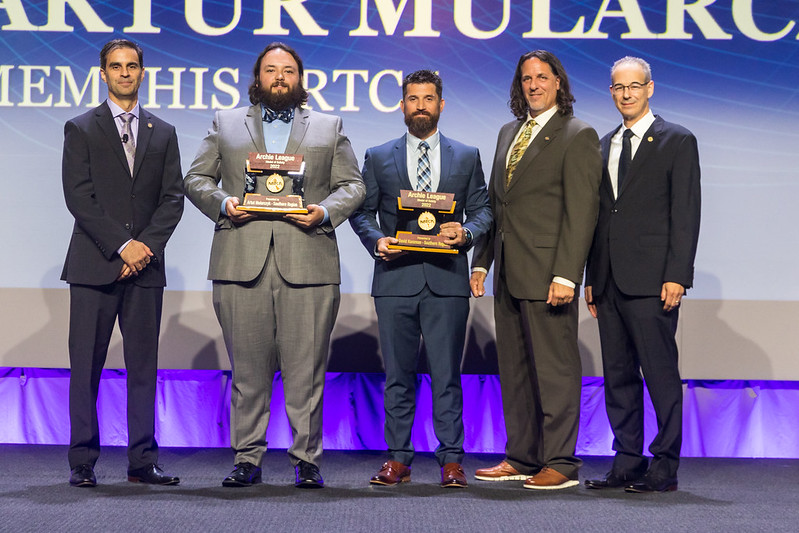
Article by Amy Sayers (Fort Lauderdale ATCT, FLL)
On a beautiful day in April, Memphis Center (ZME) member David Kunzman was training Artur Mularczyk on routine traffic. They were working the R65 sector, which comprises of many military operating areas (MOAs), military training aircraft, along with general aviation traffic and commercial traffic.
Around 4 p.m., OSHN154, a flight of two single-engine military training aircraft, announced on a MOA frequency that they were exiting the airspace and going to Naval Air Station Meridian (NMM) due to an emergency. These frequencies remain on speaker and are continually monitored by the center controllers. Kunzman and Mularczyk heard the pilot was exiting the airspace and were awaiting OSHN154 to check in with them.
At this point, they didn’t know the nature of the emergency or the urgency of the situation. When OSHN154 checked in, he stated he was 68 miles off Navy McCain with an emergency. Mularczyk asked what his intentions were and OSHN154 said he was going to Key Field for a precautionary straight-in.
Mularczyk cleared the flight for the recovery to Key Field and asked if he needed equipment to stand by and what the nature of his emergency was. OSHN154 replied that he did not require equipment and that he had reduced thrust on his aircraft.
Shortly after this exchange, OSHN154 called and told Mularczyk that he didn’t know if he was going to make it to Key Field. The pilot immediately began asking about Hesler-Noble Field Airport (LUL), an airport only 23 miles away. OSHN154 recognized that this was a better choice and asked for a vector towards LUL.
Next to Mularczyk was Kunzman, his trainer, who pulled up the latitude and longitude, runway configuration, UNICOM frequency, and wind for LUL, provided it to Mularczyk, who then relayed it to the pilot.
Mularczyk gave OSHN154 a descent to 3,000 feet and cleared them to LUL, and OSHN154 then switched to UNICOM frequency.
Due to the center’s unreliable reception of the UNICOM frequency, Mularczyk requested an aircraft that was currently on their frequency to monitor LUL’s UNICOM, asking them to listen for OSHN154 checking in and to relay any information to them. Shortly after this request, that aircraft was told that they no longer needed to monitor because they had gotten word that OSHN154 had landed safely. The wingman had continued their flight and had returned to base.
After this event, the pilot of OSHN154 called Memphis Center and explained that, due to the nature of their emergency, there was no way they were going to make it to Meridian Airport and if it were not for Mularczyk and Kunzman being prepared with the necessary information that he needed to land at LUL in such a short amount of time, he would have had to eject.
“David and Artur were the pinnacle of professionalism that we strive for as air traffic controllers. They responded quickly and without hesitation. The motto “Every day is a training day” was truly in play as Artur was training at the time. They assisted the pilot and avoided a catastrophic outcome by communicating with surrounding aircraft and team members to make sure they could continue to monitor and share information with the pilot throughout the emergency. This was the epitome of teamwork as instructor and trainee worked together to bring about a successful resolution. Following the event, the pilot called the facility to let everyone know that David and Artur saved not just valuable equipment and the aircraft, but his life.”
– NSO Regional Vice President Jim Marinitti
Watch the award presentation:
Highlights from this event:
PODCAST: Listen to a conversation with about this event.
Southwest Region: Kerri Fingerson (formerly Phillips, currently at ZBW), Megan Baird – Fort Worth Center (ZFW)
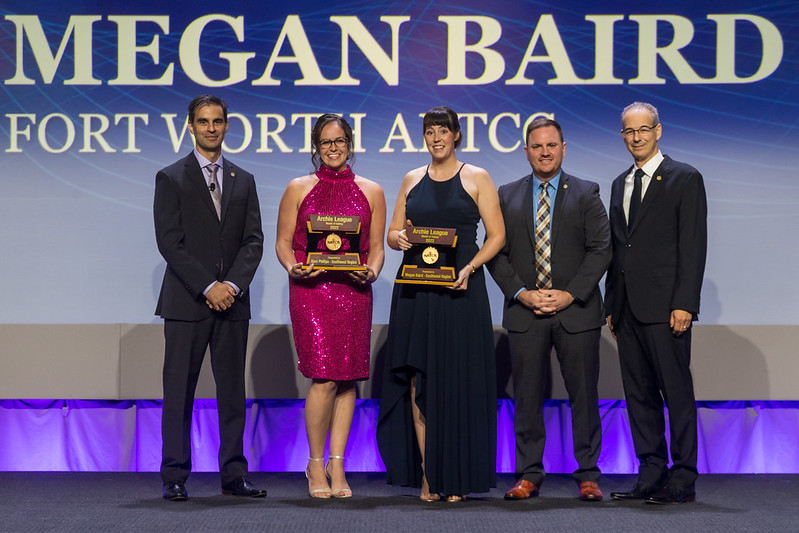
Article by Mary Ann Hall (Houston Hobby ATCT, HOU)
On April 23, 2021, the skies over Oklahoma were riddled with areas of precipitation and low ceilings. At 4:51 p.m., N7108Q, a Cessna 172, executed a missed approach at Clinton Regional Airport (CLK). He immediately requested another RNAV approach onto Runway 17. Fort Worth Center (ZFW) member Kerri Fingerson (formerly Phillips) was working a low sector in the Bowie Specialty. She did what every controller would do – radar ID, clarified his intentions, and cleared him back to Clinton Regional. Kerri did ensure the pilot had the most recent weather report which included a visibility of 1.5 nautical miles and an overcast ceiling at 400 feet.
Soon after Fingerson cleared and switched N08Q to advisory, she called the tower at neighboring airport to the west, Clinton-Sherman (CSM), to ask about its current weather conditions. The airport was socked in. She inquired north to Kansas, farther west to Elk City (ELK) and south to Wichita Falls (SPS) – all reported low ceilings. Will Rogers Airport (OKC) to the east had better weather conditions, but heavy to extreme precipitation stood in the way. It was then that N08Q missed again.
“I had that ‘Spidey’ sense – that tingling feeling you know – that something just wasn’t right,” Fingerson recounted.
Instead of flying the published missed approach, which is runway heading for 12.5 nautical miles and climbing to 4,000 feet, the pilot made a sharp left turn and checked in with departure at only 2,800 feet.
“I knew at that point that he knew he was in trouble even though he really hadn’t admitted it verbally yet,” Fingerson said.
She immediately informed the pilot that minimum IFR altitude was 4,000 feet and instructed him to climb and fly the published missed. No response. She gave the instructions again, and he finally responded.
22:27:23Z: “N7108Q…do you need any assistance?”
22:27:29Z: “Eh…we…uh…we are getting set up.”
22:28:17Z: Kerri informed the pilot his heading was better and proceeded to give airport weather reports.
22:29:04Z: “Okay we have about 50 minutes of fuel left. Uh we need to do something quick.”
Fingerson acted immediately and got on the phone with Sheppard Air Force Base-Wichita Falls Municipal Airport (SPS) to verify its ceiling improved to 1,200 feet overcast. Once she received confirmation, she was back with N08Q to relay that option. The pilot initially said that he was only in a C172, and he would, “try this one more time here and I’ll make her in.” Fingerson knew that was not a good idea.
With the pilot being in a slow-moving Cessna, she informed him that SPS was about 90 miles to the south and with only 50 minutes of fuel remaining he would be short on options if he failed the third approach. The pilot agreed. Not only was the weather against them, but now so was time.
ZFW member Megan Baird was coming back from break but was not assigned a position yet. She had overheard Fingerson and sensed she might need assistance, so she plugged in next to her and asked what she could do to help. Together they called around to find better weather reports and PIREPs. A call to Fort Sill Approach determined the Lawton Airport (LAW) had an overcast ceiling at 500 feet and Duncan Airport (DUC) had a scattered layer at 800 ft and an overcast ceiling at 1,200 feet. While still 75 nautical miles away, Duncan became the new objective.
Fingerson and Baird got back on the line with Fort Sill Approach to request shutting down the restricted area that laid between Clinton Regional and Fort Sill’s airspace, so N08Q could fly the quickest route. As the pilot made his way southeast bound, the controllers were still calling to get weather reports at closer airports, but Duncan remained the best option. The pilot reported two souls on board and since he was flying more efficiently, he now had 60 minutes of fuel, but it was about a 44-minute flight to Duncan.
Fingerson had been waiting on a PIREP from an Envoy making an approach at Lawton Airport. Once the aircraft landed, she learned the bases were 2,000 feet. Lawton is 35NM closer than Duncan, so they changed course. Fingerson offered a higher altitude for fuel conservation, but N08Q decided to maintain his current altitude of 4,500 feet. Next, she vectored him towards LAW VOR, and later switched him to Fort Sill Approach. 22 minutes after the switch and with only about 14 minutes of fuel remaining, N08Q landed safely at Lawton Airport after flying a surveillance approach.
“Kerri’s decisive action, clear communication, and potentially lifesaving recommendation ensured the successful outcome for the crew of N7108Q,” said Joel Hays, Fort Worth Center NATCA Vice President.
When asked if there was any training that helped prepare her for this event, Fingerson responded that back in 2019, Women for Aviation International (WIA) hosted a breakfast during AirVenture at OshKosh, and the guest speaker was Tammy Jo Shults (also a speaker at this year’s CFS).
Fingerson said that Tammy is very inspirational and quoted her saying, “Habits become instinct under pressure.” That statement resonated with her. Fingerson recalled her first trainers and how they instilled good practices in her from her early years as an air traffic controller, and she continues to learn with recurrent training.
“All of that really paid off – those habits that you develop during training – they do become instinct,” Fingerson said.
Fingerson and Baird are the 11th and 12th ZFW members to win the Archie League Medal of Safety Award, joining Chris Owen in 2005, LouElla Hollingsworth in 2013, Phil Enis, Thomas Herd and Hugh Hunton in 2018, Larry Bell, Brian Cox, and Colin McKinnon in 2020, and John (Randy) Wilkins and Christopher Clavin also in 2020.
“Kerri has worked to elevate the safety culture at ZFW through her work on the LSC. She put her talents and lessons learned into action and provided critical information to ensure the best possible outcome for N7108Q. At ZFW we emphasize being a team player – see something, say something. Megan exemplified this mantra when she took swift action to help Kerri in a very difficult scenario. Megan’s actions show that we are part of the ultimate team sport and set an example of embracing that very important concept.”
– Nick Daniels, Southwest Regional Vice President
Watch the award presentation:
Highlights from this event:
PODCAST: Listen to a conversation with about this event.
Western Pacific Region: Colby Alford, Matthew Cox, Dan Hauptman, Eric Joe – Las Vegas TRACON (L30)
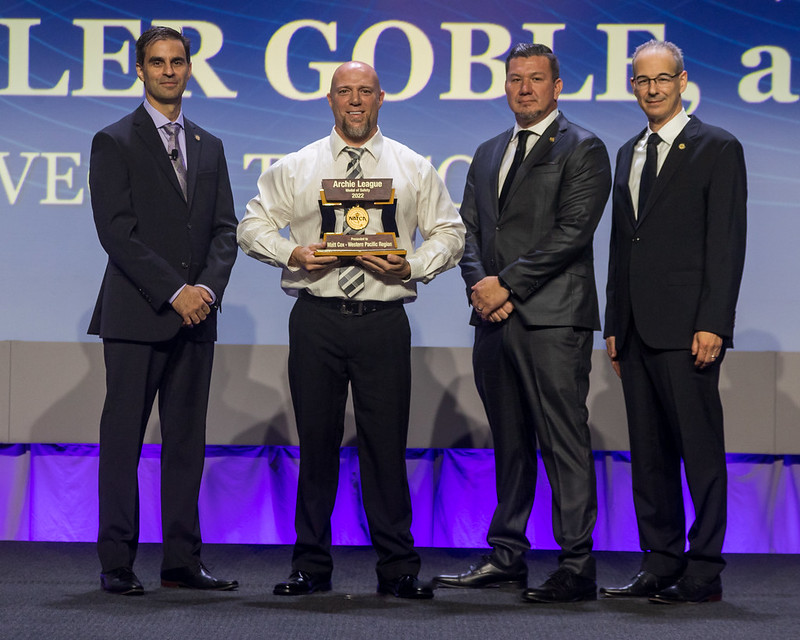
Matthew Cox
Article by Robert Reddeg (Southern California TRACON, SCT)
On the chilly desert evening of February 15, 2022, NATCA members Matt Cox, Eric Joe and the training team of Dan
Hauptman and Colby Alford were having a routine shift at Las Vegas TRACON (L30). Cox was working the Granite sector when N77FH, a Beech Bonanza (BE35), inbound to Boulder City Airport (BVU), checked in VFR, and stated that he needed assistance.
N77FH was having problems maintaining VFR and had climbed into Class A airspace (above 18,000 feet). The pilot stated that he was at 19,300 feet, however his mode C altitude readout was not functioning. Cox identified the aircraft and accomplished a point out with Los Angeles Center to protect the area around N77FH since he was above Las Vegas TRACON’s airspace.
Cox asked if the pilot was IFR qualified, and the pilot declared that he was not but soon after N77FH stated he could see the ground and started a VFR descent. As N77FH began the descent and moved closer to Boulder City, he was switched over to the training team of Hauptman and Alford on the Daggett sector.
The pilot checked in descending through 8,000 feet, direct to Boulder City Airport. Hauptman and Alford verified the intentions of N77FH, issued the Las Vegas altimeter and continued his descent along with a vector to Boulder City Airport. Within seconds, N77FH turned sharply right of course raising Hauptman and Alford’s concern. At this point, Hauptman took over as the instructor recognizing something was wrong and he verified the assigned heading to N77FH, the pilot acknowledged, apologized, and turned back on course.
During this time N77FH encountered IFR conditions, lost control of the aircraft and became inverted, regained control, lost engine power, restarted the engine, regained control, and navigated on course with the help of Hauptman’s calm voice. Hauptman helped N77FH continue to Boulder City Airport but now the pilot was unable to see the airport due to his altitude and cloud cover below him. The team of Joe and others in the control room started using all their tools including additional aircraft on their frequencies to help get the lights turned on at Boulder City Airport since it is a non-controlled airport. As work was done to get the lights turned on, Hauptman continued to provide landing information and instructions until the pilot was able to locate the airport and land safely.
“Dan, Matthew, Eric, Colby, and Tyler’s actions and teamwork on Feb. 15 were nothing short of heroic. This event is a reminder that our members are constantly working to ensure that our National Airspace System is safe and efficient. Their actions represent the calm professionalism, skill, and training that is a hallmark of all air traffic controllers and other aviation safety professionals and ensured that Bonanza N77FH had a safe outcome.”
– Western Pacific Regional Vice President Joel Ortiz
Watch the award presentation:
Highlights from this save:
PODCAST: Listen to a conversation with these NATCA members.
Honorable Mention
NAL – Alaskan Region
Alexia Snyder, FAI
Matt Freidel, ZAN
Erin Berg, ZAN
NCE – Central Region
Jesse Ramsey, ZKC
NEA – Eastern Region
Anthony Nilson, N90
Matthew Crumrine, EWR
Amber Bailey, ZDC
James Ennis, ZDC
Chelsea Arias, ZDC
Dylan McLoughlin, ZDC
Nicholas Glorioso, ZDC
Yelizaveta Reznikova, ZDC
NGL – Great Lakes Region
Adam Lilly, ZOB
Shawn Adams, ZOB
Melanie Robinson, ZOB
Andrew Hill, ZOB
Justin Summers, DTW
Matthew Smiertka, GRR
Aaron Tessmer, GRR
NNM – Northwest Mountain Region
Christopher Worthey, APA
Aaron Morell, APA
Brian Delaney, APA
Allan Nelson, ZLC
Timothy Salamon, P80
Donovan Carson, P80
NSO – Southern Region
Patrick Carr, GSO
Ryan Hampton, GSO
Cory Stiely, M03
Matthew Dugan, M03
Christopher Corapi, CVG
Zachary Miles, CVG
Frederick (“Rick”) Zuckerman, CVG
John Buonadonna, CVG
Evan Lawton, TPA
NSW – Southwest Region
Ellen Albers, SAT
Todd Ells, LIT
Christian Schlick, LIT
NWP – Western Pacific Region
Stewart Merrell, PAO
Robert Brown, CMA
Paige Giles, CMA
Thomas Brautigam, CMA (currently SNA)

